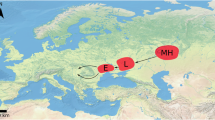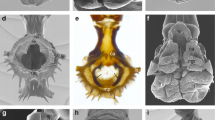Abstract
Salinomys delicatus is considered a rare species due to its restricted and patchy distribution, poor records and low abundances. It is also the phyllotine with the lowest known diploid chromosome number (2n = 18), however its sex chromosome system has never been described. Here, we studied the chromosomes of six females and three males with bands G, C, DAPI/CMA3 and meiosis. In males, the chromosome number was 2n = 19, with one large metacentric X-chromosome and two medium-sized acrocentrics absent in females. The karyotype of females was the same as previously described (2n = 18, FN = 32), with X-chromosomes being metacentric and the largest elements of the complement. In males, the two acrocentrics and the large metacentric form a trivalent in meiotic prophase. This indicates that S. delicatus has XY1Y2 sex chromosomes, which is confirmed by G and DAPI bands. Constitutive heterochromatin (CH) is restricted to small pericentromeric blocks in all chromosomes. The X-chromosome shows the largest block of centromeric CH, which could favor the establishment of this X-autosome translocation. This sex chromosome system is rare in mammals and, compared with other phyllotine rodents, S. delicatus seems to have undergone a major chromosome restructuring during its karyotypic evolution.


Similar content being viewed by others
References
Ashley T (2002) X-Autosome translocations, meiotic synapsis, chromosome evolution and speciation. Cytogenet Genome Res 96:33–39
Braun JK, Mares MA (1995) A new genus and species of Phyllotine rodent (Rodentia: Muridae: Sigmodontinae: Phyllotini) from South America. J Mamm 76:504–521
Castro EC, Mattevi MS, Maluf SW, Oliveira LFB (1991) Distinct centric fusions in different populations of Deltamys kempi (Rodentia, Cricetidae) from South America. Cytobios 68:153–159
D’Elía G, González EM, Pardiñas UFJ (2003) Phylogenetic analysis of sigmodontine rodents (Muroidea), with special reference to the akodont genus Deltamys. Mamm Biol 68:351–364
Davisson MT, Akeson EC (1993) Recombination suppression by heterozygous Robertsonian chromosomes in the mouse. Genetics 133:649–667
Deuve JL, Bennett NC, O’Brien PCM, Ferguson-Smith MA, Faulkes CG, Britton-Davidian J, Robinson TJ (2006) Complex evolution of X and Y autosomal translocations in the giant mole-rat, Cryptomys mechowi (Bathyergidae). Chromosome Res 14:681–691
Díaz GB, Ojeda RA (1999) Kidney structure of Argentine desert rodents. J Arid Environ 41:453–461
Dobigny G, Ozouf-Costaz C, Bonillo C, Volobouev V (2004) Viability of X-autosome translocations in mammals: an epigenomic hypothesis from a rodent case-study. Chromosoma 113:34–41
Evans EP, Breckon G, Ford CE (1964) An air-drying method for meiotic preparations from mammalian testes. Cytogenetics 3:289–294
Ford CE, Hamerton JL (1956) A colchicine, hypotonic citrate, squash sequence for mammalian chromosomes. Biotech Histochem 31:247–251
Fredga K (1970) Unusual sex chromosome inheritance in mammals. Philos Trans R Soc Lond B 259:15–36
Fredga K (1988) Aberrant chromosomal sex-determining mechanisms in mammals, with special references to species with XY females. Philos Trans R Soc Lond B 322:83–95
Lanzone C, Bidau CJ, Giménez MD, Santos JL (2002) Synaptic behaviour and morphological modifications of the X and Y chromosomes during pachytene in three species of Ctenomys (Rodentia, Caviomorpha, Ctenomyidae). Genome 45:1110–1115
Lanzone C, Ojeda RA, Albanese S, Rodríguez D, Dacar M (2005) Karyotypic characterization and new geographical record of Salinomys delicatus (Rodentia, Cricetidae, Sigmodontinae). Mastozool Neotr 12:257–260
Mares MA, Braun JK (1996) A new species of phyllotine rodent, genus Andalgalomys (Muridae: Sigmodontinae), from Argentina. J Mamm 77:928–941
Marshall Graves JA (2006) Sex chromosome specialization and degeneration in mammals. Cell 124:901–914
Ojeda RA, Navarro MC, Borghi CE, Scollo AM (2001) Nuevos registros de Salinomys y Andalgalomys (Rodentia, Muridae) para la provincia de La Rioja, Argentina. Mastozool Neotr 8:69–71
Olds A, Anderson S, Yates TL (1987) Notes on Bolivian mammals 3: a revised diagnosis of Andalgalomys (Rodentia, Muridae) and the description of a new subspecies. Am Mus Nat Hist 2890:1–17
Rodríguez D, Chillo V, Albanese S, Cuello P, Lanzone C, Ojeda A, Ojeda R (2008) Nuevos registros y uso de recursos de Salinomys delicatus en el desierto del Monte, Argentina. XXII Jornadas Argentinas de Mastozoología, Villa Giardino, Córdoba Argentina
Sbalqueiro IJ, Mattevi MS, Oliveira LFB (1984) An X1X1X2X2/X1X2Y mechanism of sex determination in a South American rodent, Deltamys kempi (Rodentia, Cricetidae). Cytogenet Cell Genet 38:50–55
Schweizer D (1980) Simultaneous fluorescent staining of R bands and specific heterochromatic regions (DA-DAPI bands) in human chromosomes. Cytogenet Cell Genet 27:190–193
Seabright M (1971) A rapid banding technique for human chromosomes. Lancet 2:971–972
Steppan SJ, Ramirez O, Banbury J et al (2007) A molecular reappraisal of the systematics of the leaf-eared mice Phyllotis and their relatives. In: Kelt DA, Lessa EP, Salazar-Bravo JA, Patton JL (eds) The quintessential naturalist: honoring the life and legacy of Oliver P. Pearson. University of California Publications in Zoology, USA, pp 799–826
Sumner AT (1972) A simple technique for demonstrating centromeric heterochromatin. Exp Cell Res 7:304–306
Veyrunes F, Catalan J, Sicard B et al (2004) Autosome and sex chromosome diversity among the African pygmy mice, subgenus Nannomys (Murinae; Mus). Chromosome Res 12:369–382
Veyrunes F, Watson J, Robinson TJ, Britton-Davidian J (2007) Accumulation of rare sex chromosome rearrangements in the African pygmy mouse, Mus (Nannomys) minutoides: a whole-arm reciprocal translocation (WART) involving an X-autosome fusion. Chromosome Res 15:223–230
Acknowledgments
Our thanks to JM Ferro for his technical assistance and to Maria Eugenia Periago and Nelly Horak for their assistance with the English version. We thank Dr. Ricardo Ojeda for his continuous support and encouragement of our research, and two anonymous referees for their critical reviews of the manuscript. Financed by Rufford Small Grants (to Dr. D. Rodríguez), PIP5944 CONICET and PICT 25778 FONCyT (to Dr. R. A. Ojeda), PICTO 37035 FONCyT (to Dr. D. A. Martí), PIP198 CONICET (to Dr. C. Lanzone). The authors acknowledge the continuous support of Consejo Nacional de Investigaciones Científicas y Técnicas (CONICET).
Author information
Authors and Affiliations
Corresponding author
Rights and permissions
About this article
Cite this article
Lanzone, C., Rodríguez, D., Cuello, P. et al. XY1Y2 chromosome system in Salinomys delicatus (Rodentia, Cricetidae). Genetica 139, 1143–1147 (2011). https://doi.org/10.1007/s10709-011-9616-7
Received:
Accepted:
Published:
Issue Date:
DOI: https://doi.org/10.1007/s10709-011-9616-7




